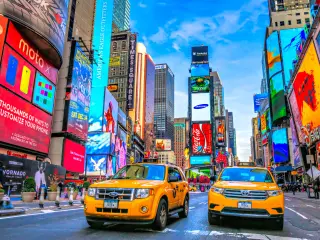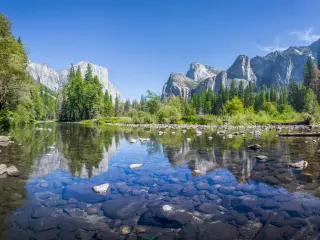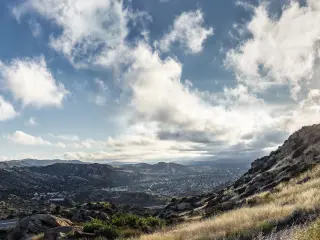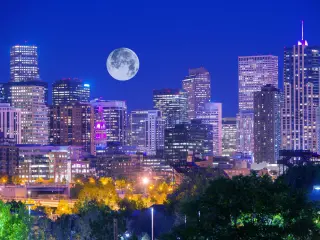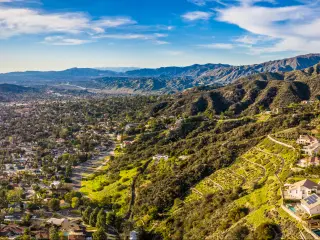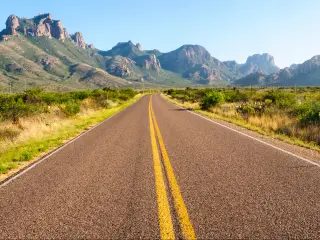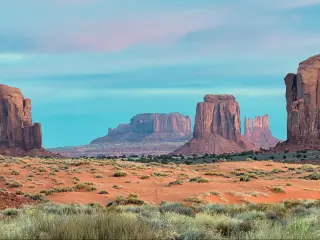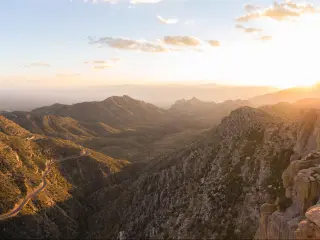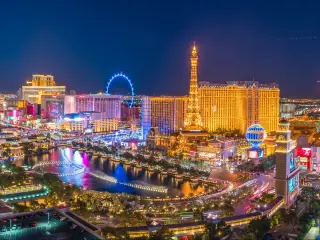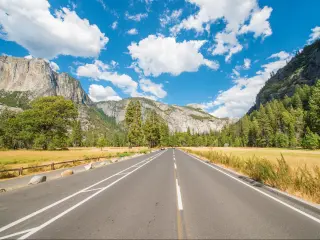The Best 7-day Road Trip from Las Vegas
This 7-day round trip takes you through stunning red rock desert landscapes, sandstone formations that will take your breath way, national parks that will impress you with their beautiful plant and wildlife, and iconic cities and monuments like the Grand Canyon, Santa Fe, Albuquerque, and Moab.
The best 7-day road trip from Las Vegas spans about 1900 miles and takes a total of 32 hours from start to finish. You'll make your way from Vegas to Flagstaff and Albuquerque, visiting the Grand Canyon and passing through several National Parks before looping back towards Sin City.
If you feel at home in the desert or surrounded by tall trees, and if you love long stretches of barren roads where you can blast your favourite tunes, this 7-day road trip is absolutely for you! Keep scrolling to find out more.
Your 7-day road trip from Las Vegas: the best day-by-day itinerary
| Day | Driving itinerary | Distance | Time |
|---|---|---|---|
| 1 | Las Vegas to Flagstaff | 250 miles | 4 hours |
| 2 | Flagstaff to Winslow | 120 miles | 2 hours 20 minutes |
| 3 | Winslow to Albuquerque | 350 miles | 6 hours |
| 4 | Albuquerque to Taos | 130 miles | 2 hours 30 minutes |
| 5 | Taos to Canyonlands National Park | 300 miles | 5 hours 30 minutes |
| 6 | Canyonlands National Park to Richfield | 230 miles | 3 hours 30 minutes |
| 7 | Richfield to Las Vegas | 330 miles | 5 hours |
What is the best 7-day road trip from Las Vegas and where will it take you to?
With an average daily drive time of about 3 hours, this 7-day road trip is an ideal combination of short driving stretches mixed with wonderful stopping points.
Apart from the Grand Canyon (a highlight of this journey) you'll also be stopping in several other parks and forests including the Apache National Forest, Cibola National Forest, Dixie National Forest and Zion National Park.
While this itinerary is definitely nature-focused, there'll be plenty of time to get some city fun in Santa Fe, Albuquerque, and Sedona.
Day 1: Driving from Las Vegas to Flagstaff
We're starting off this trip with a bang by including the Grand Canyon National Park on the first day. The first day's drive will take you 4 hours to drive, covering 250 miles.
Keep reading to discover what awaits you in your first few moments of travelling.

Road trip route from Las Vegas to Flagstaff
You'll start in Vegas where you'll take the US-93 and make your way to the Grand Canyon National Park. Once you've had your fill of this arid natural wonder, you can continue towards Flagstaff, where you'll be spending your first night.
Things to explore on the way to Flagstaff
One of the most impressive natural landscapes in the entirety of the United States, Grand Canyon National Park is a must-see and bucket-list location for anyone venturing through this part of the US. Boasting stunning canyons and red deserts, this unique national park is definitely worth exploring.
If you're looking for something else to discover on this stretch, we recommend stopping in the suburb of Henderson where you can check out the Clark County Museum, or taking a hike through Prescott National Forest, where you're sure to enjoy the stunning nature that surrounds you.
Where to stay in Flagstaff: small-town luxury
Flagstaff is known for its small-town charm and storied history, and it's a great spot to stay as it's right by the Grand Canyon. This means that you can spend the day exploring, spend the night in Flagstaff and then head out early without worrying about crowds.
One thing to keep in mind is that Flagstaff can get quite snowy due to its elevation, so be prepared for cold weather if travelling in the winter.
And if you're looking for a place to stay, we highly recommend the High Country Motor Lodge, which boasts some truly amazing amenities. You'll have access to their on-site restaurant, where you can catch an evening show, as well as their shared lounge, bar and garden.
The High Country Motor Lodge also boasts a fitness center, outdoor swimming pool and a hot tub, perfect for some well-deserved relaxation after a long drive. And to top it off, they've got free parking, so you won't have to worry about where to drop off your car when you arrive.
READ MORE - Click here for more great hotel options
Click here to skip back to the top.
Day 2: Driving from Flagstaff to Winslow
After a great night's rest, you'll be primed for the second day of travelling and exploring some neat sites. It is a rather short drive from Flagstaff to Winslow, covering 120 miles in 2 hours and 20 minutes, so you can spend most of your day exploring Sedona and Coconino National Forest.
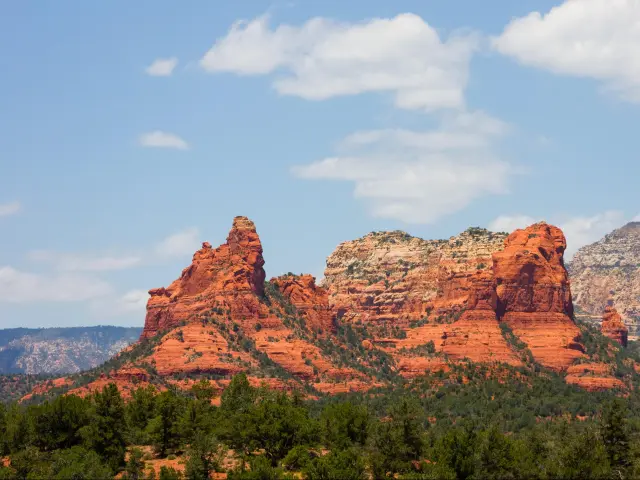
Road trip route from Flagstaff to Winslow
The driving stretch for day 2 is pretty short, about an hour in total and travelling just under 60 miles. You'll leave Flagstaff and head towards Sedona via the 89A.
Then, when you've finished exploring the many unique attractions within and surrounding Sedona, head back up towards Flagstaff, this time diverting right onto the I-40 and continuing until you've reached Winslow.
Things to explore on the way to Winslow
There are tons of things to explore along this relatively short stretch. Sedona (and the nearby Montezuma Castle National Monument) are absolutely worth a visit.
A town surrounded by the Arizona Desert, Sedona boasts tons of New Age shops, spas and art galleries; nearby Montezuma Castle is a historic palace carved directly into limestone cliffs.
You can also check out Coconino National Forest. Touted as one of the most diverse national forests in America, Coconino National Forest offers a variety of natural landscapes ranging from red rocks to alpine tundras.
Once you've finished exploring Sedona, we recommend you spend a little time exploring the over 1.8 million-acre forest of this celebrated park.
Where to stay in Winslow: explore the historic roots of Route 66
Winslow is a small city along your route, known mostly as being an important stop along the famous Route 66. It's also celebrated for its mention in the Eagle's “Take it Easy”, which features a verse about standing on a corner in Winslow (which is now a dedicated park).
Winslow is also a great base to explore some of the fascinating surrounding landmarks and attractions. You can easily reach Sedona and Coconino National Forest from the city. Make sure to visit the Meteor Crater as well!
While visiting this city, Homolovi State Park is a must-visit for all archaeology and history buffs. However, if you are a more outdoorsy person, you can visit McHood Park to enjoy kayaking and canoeing.
We've got a great hotel option for this small town: the La Posada Hotel and Gardens. This historic and frankly iconic hotel is known for having hosted some of history's greatest American personalities, including Amelia Earhart, James Cagney, Franklin D. Roosevelt and John Wayne. If the walls could talk!
Apart from its famous guests, La Posada boasts a garden and martini bar where you can enjoy a refreshing drink, as well as an old-school trading post and book store. The hotel also offers some delicious food at i's on-site restaurant, as well as room service.
Click here to skip back to the top.
Day 3: Driving from Winslow to Albuquerque
This third day of traveling takes you from Winslow to Albuquerque, with about 350 miles of travel covered in a 6-hour period. It's the longest travel day, but also packs in tons of cool natural attractions.
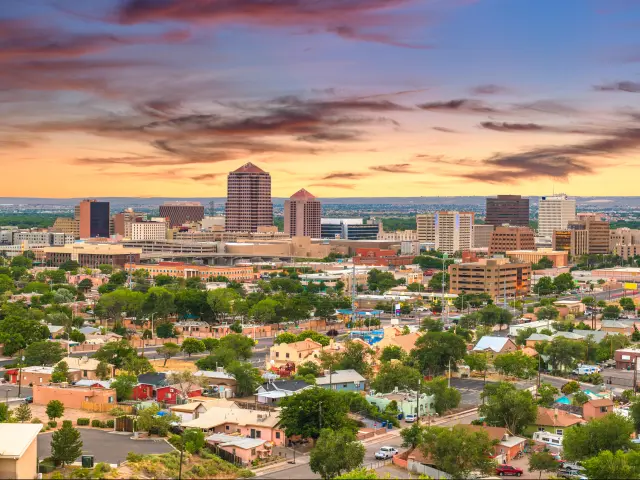
Road trip route from Winslow to Albuquerque
You'll leave Winslow via I-40 and continue along this interstate until you reach Holbrook, where you'll take Exit 285 and continue along US-180. Merge onto the US-191 and continue to Springerville, where you can make a stop to explore the nearby Apache National Forest.
Once you've had your fill of this celebrated forest, hop into your car and direct yourself towards US-60. From there, slowly make your way back towards I-40, which will take you all the way to Albuquerque as well as the nearby Cibola National Forest.
Things to explore on the way to Albuquerque
This third day combines exploration of natural spaces with the urban bustle of Albuquerque. Along the way, one spot we definitely suggest you explore is The Apache-Sitgreaves National Forests.
The Apache-Sitgreaves National Forests are most known for their many bodies of water; over thirty lakes and reservoirs, and more than 690 miles of river and streams. The park itself spans over two million acres of forest and encompasses some really diverse landscapes, including stunning mountainous country.
If you've got some time to spare, check out the nearby Cibola National Forest. Spanning across the width of New Mexico and including the grassy plains of Oklahoma and Texas, the Cibola National Forest spans over 1.9 million acres, offering tons of vistas and unique walking trails.
Where to stay in Albuquerque: unwind and re-energize
Known for being a technology and media company hub, Albuquerque also boasts tons of historic landmarks and celebrated festivals like the International Balloon Fiesta and the New Mexico State Fair.
This city is a great spot to stop on this road trip, offering great dining opportunities and a unique set of attractions. And if you're looking for a spot to stay while visiting, then Casas de Suenos Old Town Historic Inn offers a charming stay, packed with authenticity and great amenities.
This interesting accommodation, built in 1938, blends Southwestern décor style with contemporary design. The spacious casitas, have hidden courtyards and there are some hot tub suites, providing a peaceful retreat after a day exploring.
You can also make sure to start the day off right at the on-site restaurant, serving up hot breakfast options cooked to order. Make sure to try the green Chile burritos!
READ MORE - Click here for more great hotel options
Click here to skip back to the top.
Day 4: Driving from Albuquerque to Taos
This day takes you from Albuquerque to the small city of Taos, which marks the turnaround point of this journey. The drive itself is about 2 hours 30 minutes and spans about 130 miles. Keep reading to discover what awaits you on Day 4.

Road trip route from Albuquerque to Taos
After a night in the stunning Crowne Plaza accommodations, we're sure you'll feel relaxed and ready to head back on the road. Exit Albuquerque via I-25, which takes you to the historic city of Santa Fe.
Nearby, you'll find the wonderful Santa Fe National Forest, which you can visit before getting onto the US-68 from Santa Fe and continuing to Taos.
Things to explore on the way to Taos
Due to the relatively short driving time on day 4, you'll have plenty of time to explore the surrounding sites.
We highly recommend spending some time exploring the beautiful and historic city of Santa Fe. Known as the artistic counterpart to the industrial center that is Albuquerque, Santa Fe boasts a really rich and booming classical music and arts scene.
The city also happens to be the oldest capital in the United States and is nationally celebrated for its wonderful Spanish colonial architecture and rich Native American culture.
If you've got some time left over after exploring Santa Fe, we suggest checking out the Bandelier National Monument, which boasts over 33,000 acres of canyon and mesa country housing evidence of human settlements, dating back over 11,000 years.
Where to stay in Taos: an immersive desert resort
We recommend staying at the El Monte Sagrado Resort & Spa while visiting the unique city of Taos. Boasting stunning outdoor landscapes and gardens, the El Monte Sagrado will have you feeling like you've been immersed in the desert jungle.
You'll also have plenty of opportunities to relax at this resort's full-service spa, which offers massages, facials, and tons of other therapeutic services. If that's not enough, you can always enjoy a workout or a dip at this hotel's indoor pool and fitness center.
If you're looking for a place to dine in the evening, check out El Monte Sagrado's two restaurants, De La Tierra and The Gardens. And for a drink afterwards, we recommend you check out the resort's Anaconda Bar.
Want to explore Taos? We highly recommend you check out The Taos Pueblo, a collection of adobe dwellings that have been inhabited for 1000 years and located just 10 minutes by car from the resort.
This happens to also be the only living Native American community with both the UNESCO World Heritage Site and National Historic Landmark designation. Overall, a great place to explore overnight.
Click here to skip back to the top.
Day 5: Driving from Taos to Canyonlands National Park
On day 5, you'll be driving from Taos to the iconic Canyonlands National Park. This stretch spans about 300 miles, which should take you about 5 hours 30 minutes to cross in total.
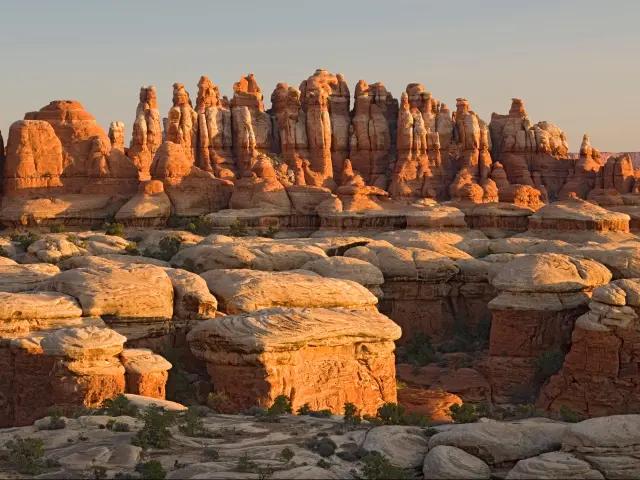
Road trip route from Taos to Canyonlands National Park
From Taos, take US-64; you'll have the option of stopping at Carson National Forest, which is located right along the route. This road should be pretty scenic, so make sure to have your passenger ready with a camera to snap some great shots.
Continue along the US-64, which will turn into the US-84; follow this road to Pagosa Springs. Here you can hop out and explore the Rio Grande National Forest, or continue along the US-160 passed Durango and until you've reached Monticello.
Things to explore on the way to Canyonlands National Park
There are a couple of unique forests to explore along this stretch, including the San Juan National Forest and the Rio Grande National Forest.
The Rio Grande National Forest spans 1.8 million acres and offers year-round opportunities for sightseeing throughout its many natural landscapes. This park also offers ample opportunities for recreational activities, so it's a great way to get a little active on this road trip.
If you've got some additional time on your hands, we recommend checking out the Hovenweep National Monument, a preserve that's home to over 2,500 people and which is comprised of six prehistoric villages, all built between 1200 and 1300 A.D.
You'll have to add about 30 minutes to your route to explore this monument, and we highly recommend you do as it's definitely worth it.
Where to stay in Monticello: get cozy in a charming town
Monticello, Utah is most known for being an early settlement area, settled by pioneers from the Mormon church in 1887. The city itself is quite small, offering a relaxed vibe that'll be much appreciated in the last few days of your road trip.
This is also the perfect place to base yourself in as you explore Canyonlands National Park. This stunning and unique national park is split into four districts and you will want to put aside a day or two to explore The Needles, Island in the Sky, The Maze, and the rivers.
While visiting Canyonlands National Park, make sure to marvel at Mesa Arch. This geological formation is possibly the most famous area in the park and stills majestically on a cliff.
You can take in some of the amazing scenery of the surroundings at Grand Viewpoint, Green River Overlook, Shafer Trail Viewpoint and Buck Canyon Overlook.
Looking for a spot to stay? We recommend the Inn at the Canyons, a small hotel that offers quaint décor and a relaxing atmosphere. The hotel boasts an expansive pool and hot tub, so you can relax and enjoy a dip after a day of trekking and hiking.
The Inn at the Canyons also boasts a daily continental breakfast, so you don't have to worry about where to grab the most important meal of the day.
Click here to skip back to the top.
Day 6: Driving from Canyonlands National Park to Richfield
This penultimate day of driving takes you from Canyonlands National Park to Richfield, crossing about 230 miles which should take you about 3 hours 30 minutes in total.
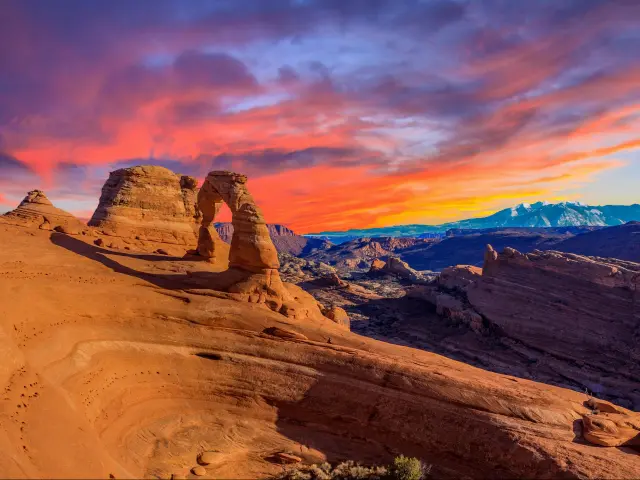
Road trip route from Canyonlands National Park to Richfield
On your way out of Monticello, we recommend making a stop in Canyonlands National Park to explore this arid desert paradise. Once you've had your fill, get onto the US-191 and follow this until you can turn left onto the I-70.
From there, continue on this road past Salina until you've reached the small town of Richfield, where you'll be spending the night.
Things to explore on the way to Richfield
Apart from the Canyonlands National Park, there are tons of other open and natural spaces that are ripe for exploration on your way to Richfield. One spot you should definitely check out is Arches National Park.
Arches National Park is a truly unique protected space, most celebrated for being home to over 2000 natural stone arches, hundreds of soaring pinnacles, massive rock fins and giant balanced rocks. It's the spot to check-out for those that are fans of red desert landscapes—you can even take a guided tour, or simply enjoy hiking this park solo.
If you've got some more time on your hands, try exploring Moab, UT. Moab is probably most celebrated for being located close to the Moab Desert, a stunning barren desert landscape.
That being said, the city itself also boasts lots of attractions, including some unique restaurants and cute shops that'll be a welcome urban experience after a few days of driving through the desert.
Where to stay in Richfield: a comfortable stop
More a stopover city than a destination, Richfield still manages to some really unique attractions, including the Richfield tabernacle (often visited by the Utah Symphony and Opera Company) as well as lots of shopping opportunities.
Our favourite accommodation out of the somewhat limited selection in this area is the Holiday Inn Express Richfield, a classic road trip hotel. Unfussy and highly reviewed, the Holiday Inn Express boasts an indoor pool and hot tub, as well as a fitness centre, where you can burn off some steam after a day of driving.
Best of all, this hotel offers a deluxe continental breakfast, serving cinnamon buns, eggs and baked goods – eat breakfast there, then pack yourself some food for the journey.
Click here to skip back to the top.
Day 7: Driving from Richfield to Las Vegas
On this last day, you'll be driving about 330 miles from Richfield all the way back home to Las Vegas. This drive should take you just over 5 hours and will get you back home in time for dinner.
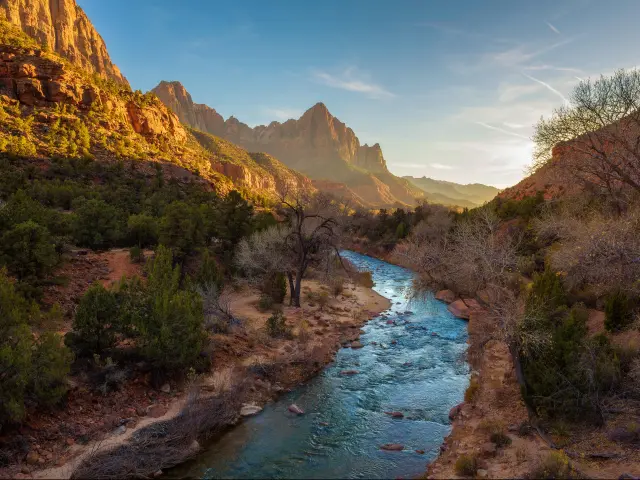
Road trip route from Richfield to Las Vegas
The drive from Richfield to Las Vegas includes several stops at stunning protected spaces along the way, including Dixie National Forest and Zion National Park.
The route itself is pretty simple: follow the US-89 to Bryce Canyon and Dixie National Forest, where we definitely recommend you take some time to explore. Once you've had your fill of this arid paradise, hop back into the car and onto the I-15 which will take you to Zion National Park.
Explore this stunning green space before heading back on the road, once again hopping onto the I-15 which will take you straight back home to Las Vegas.
Things to explore on the way back to Las Vegas
One of Utah's most celebrated national parks, Zion National Park is probably best known for Zion Canyon, an expansive canyon that averages at 2000 feet deep and offers some unique hiking opportunities. There's also the nearby Virgin River, where you can go for a swim.
Though we could definitely spend a whole day exploring Zion National Park, nearby Dixie National Forest is also worth checking out. Known for sandstone formations, this park is also viewable view a scenic drive called Hell's Backbone.
Click here to skip back to the top.
Things to see on a 7-day road trip from Las Vegas
We've detailed some of the many attractions along your route above, but here are some additional museums, monuments and other attractions that will enrich your already wonderful trip.
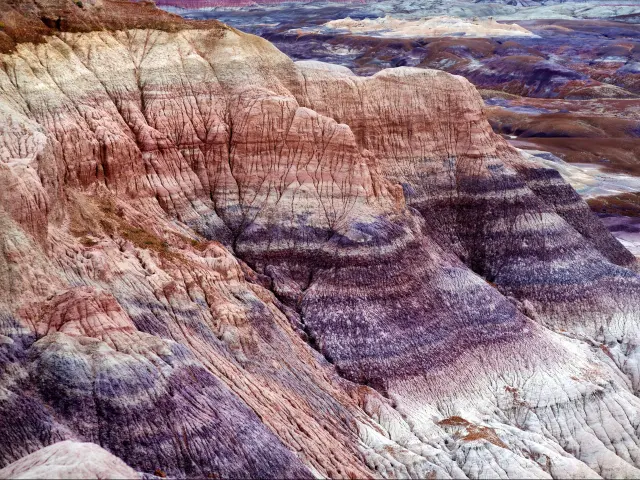
- Lava River Cave – Discover this mile-long underground tunnel, created by a river of lava over 700,000 years ago and located about an hour from the Grand Canyon.
- Museum of Northern Arizona – This museum boasts tons of exhibits dating back to 15,000 BC and which explore the rich history of the state of Arizona.
- Petrified Forest National Park – The name says it all: this unique forest boasts the world's largest collection of petrified wood, some of which date back millions of years.
- National Museum of Nuclear Science & History – If you're curious about the history of nuclear power and the development of nuclear science, we recommend checking out this unique museum.
- National Scouting Museum – Check out this unique museum, featuring some artworks by American painter Norman Rockwell as well as hands-on exhibits and artifacts relating to the Boy Scouts of America.
- Pioneer Town – Located in Cedaredge Colorado, Pioneer Town spans five acres and is comprised of twenty buildings that are dedicated to recreating life in the late 1800s and early 1900s. Adds about two hours driving to your route, but well worth it!
- Giant Soda Cans – This one's a quickie, but a must-see: the Giant Soda Cans are a favourite roadie attraction and are comprised of massive tanks painted to resemble some familiar soda drinks.
- Parowan Gap Petroglyphs – Discover these Native American Petroglyphs, which scientists believe are over 1000 years old!
- Temple of Sinawava – Located within Zion National Park, the Temple of Sinawava is a natural amphitheater complete with waterfalls and flower gardens.
- Moqui Cave – Check out Moqui Cave, once a speakeasy but now offering exhibits on natural history and boasting a great rock collection and gift shop.

Best time to go on a 7-day road trip from Las Vegas
While this area is certainly worth exploring any time of year, we recommend taking this road trip during the fall and spring months, when you'll be able to avoid the scorching hot desert temperatures or the significant snowfall in higher-altitude locations.
Traveling in winter
Winter is a great time to take this road trip if you're comfortable dealing with some snow, particularly in towns like Flagstaff which are known to see over 100 inches of snow a year. That being said, you might find that prices for lodging are slightly lower as a result.
You will be traveling through Arizona, New Mexico, Colorado and Utah. While the southern states tend to be warmer during the winter, with temperatures in Arizona reaching high 60 degrees Fahrenheit even in winter.
However, it is a good idea to bring some chain and winter tires with you, which will be especially helpful as you cross Colorado.
Traveling in summer
This collection of states—Arizona, New Mexico, Colorado, Utah and Nevada—are known to get quite hot during the summer, with temperatures in certain areas exceeding 100 degrees Fahrenheit. If you're particularly sensitive to the heat we recommend avoiding traveling during the summer.
While it does get quite hot, you can still expect some traffic in the National Parks, and as a result, some of the accommodation prices may be higher.
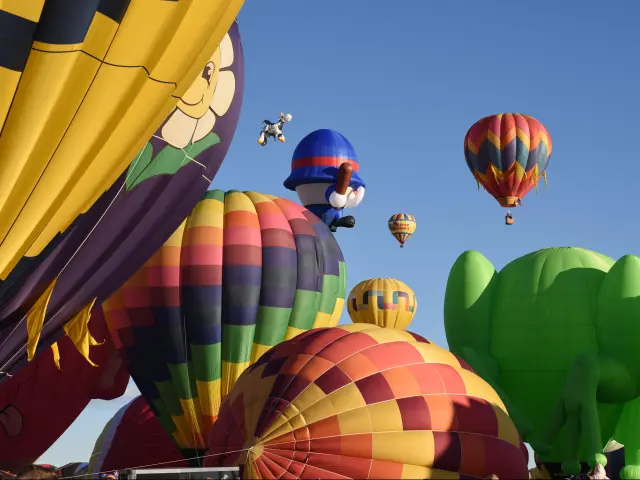
Traveling in spring and fall
Spring and fall are both great times to take on this trip--you'll find that there are fewer tourists and more affordable accommodations, but the weather is still relatively warm, meaning you'll be able to enjoy the natural landscapes and deserts.
And if you're looking to experience some memorable events, try taking this road trip during one of the following events: The Grand Canyon Music Festival, Fiestas Santa Fe, the New Mexico State Fair, Moab Folk Festival and the Red Rocks Arts Festival.

